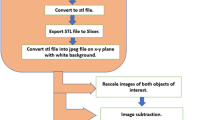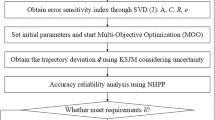Abstract
The printing accuracy is one of the most important metrics to evaluate the additive manufacturing (AM) machine. In this paper, an error identification and compensation method for Cartesian 3D printer is presented based on a specially designed test artifact to improve printing accuracy. The relationship between the geometric errors of the printed object and the kinematic errors of the printer axes is established based on the theory of the multi-body system. A series of formulas are derived to separate the kinematic errors of each axis from the geometric errors. To extract the geometric errors required for the mathematical calculations, an artifact with the special features is proposed and printed. The geometric errors of the characteristic points on the artifact are measured by a coordinate measuring machine (CMM). From the measured geometric errors, kinematic errors of the printer can be identified, and can be further compensated by adjusting the CAD model of the object. Two compensated algorithms are established; one uses the fitted curves of the kinematic errors, and the other uses the average kinematic error values. Printing tests and case studies are performed to verify the effectiveness of the proposed method. The results show that the proposed method can improve printing accuracy of the Cartesian 3D printer.










Similar content being viewed by others
Data availability
Not applicable.
Code availability
Not applicable.
Abbreviations
- \({}_{b}{}^{a}{T}_{p}\) :
-
The initial position matrix
- \({}_{b}{}^{a}{T}_{pe}\) :
-
The error matrix of the initial position
- \({}_{b}{}^{a}{T}_{k}\) :
-
The dynamic position matrix
- \({}_{b}{}^{a}{T}_{ke}\) :
-
The error matrix of dynamic position
- \({}_{b}{}^{a}{T}_{i}\) :
-
The ideal position matrix
- \({}_{b}{}^{a}{T}_{a}\) :
-
The actual position matrix
- \({E}_{p}\) :
-
The geometric error of point P
- \({E}_{px}\) :
-
The geometric error of point P in the x-direction
- \({E}_{py}\) :
-
The geometric error of point P in the y-direction
- \({E}_{pz}\) :
-
The geometric error of point P in the z-direction
- \({\alpha }_{ab}\) :
-
The angle around the X-axis between body a and b
- \({\beta }_{ab}\) :
-
The angle around the Y-axis between body a and b
- \({\gamma }_{ab}\) :
-
The angle around the Z-axis between body a and b
- \({i}_{ab}\) :
-
The linear offset between body a and b at the X-direction
- \({j}_{ab}\) :
-
The linear offset between body a and b at the Y-direction
- \({k}_{ab}\) :
-
The linear offset between body a and b at the Z-direction
- \({\theta }_{x}\) :
-
The rotational angle around the X-axis
- \({\theta }_{y}\) :
-
The rotational angle around the Y-axis
- \({\theta }_{z}\) :
-
The rotational angle around the Z-axis
- \({x}_{ab}\) :
-
The linear displacement in the X-axis between body a and b
- \({y}_{ab}\) :
-
The linear displacement in the Y-axis between body a and b
- \({z}_{ab}\) :
-
The linear displacement in the Z-axis between body a and b
- \({\delta }_{X\left(x\right)}\) :
-
The servo error of the X-axis
- \({\delta }_{Y\left(x\right)}\) :
-
The horizontal straightness error of the X-axis
- \({\delta }_{Z\left(x\right)}\) :
-
The vertical straightness error of the X-axis
- \({\varepsilon }_{\alpha \left(x\right)}\) :
-
The roll error of the X-axis
- \({\varepsilon }_{\beta \left(x\right)}\) :
-
The pitch error of the X-axis
- \({\varepsilon }_{\gamma \left(x\right)}\) :
-
The yaw error of the X-axis
- \({\delta }_{X\left(y\right)}\) :
-
The horizontal straightness error of the Y-axis
- \({\delta }_{Y\left(y\right)}\) :
-
The servo error of the Y-axis
- \({\delta }_{Z\left(y\right)}\) :
-
The vertical straightness error of the Y-axis
- \({\varepsilon }_{\alpha \left(y\right)}\) :
-
The roll error of the Y-axis
- \({\varepsilon }_{\beta \left(y\right)}\) :
-
The pitch error of the Y-axis
- \({\varepsilon }_{\gamma \left(y\right)}\) :
-
The yaw error of the Y-axis
- \({\delta }_{X\left(z\right)}\) :
-
The horizontal straightness error of the Z-axis
- \({\delta }_{Y\left(z\right)}\) :
-
The vertical straightness error of the Z-axis
- \({\delta }_{Z\left(z\right)}\) :
-
The servo error of the Z-axis
- \({\varepsilon }_{\alpha \left(z\right)}\) :
-
The roll error of the Z-axis
- \({\varepsilon }_{\beta \left(z\right)}\) :
-
The pitch error of the Z-axis
- \({\varepsilon }_{\gamma \left(z\right)}\) :
-
The yaw error of the Z-axis
- \(\Delta {\gamma }_{xy}\) :
-
The squareness error between the X-axis and Y-axis
- \(\Delta {\beta }_{xz}\) :
-
The squareness error between the X-axis and Z-axis
- \(\Delta {\alpha }_{yz}\) :
-
The squareness error between the Y-axis and the Z-axis
- ex1:
-
The geometric error in the X-direction of the original model
- ey1:
-
The geometric error in the Y-direction of the original model
- ez1:
-
The geometric error in the Z-direction of the original model
- ex2:
-
The geometric error at the X-direction of the compensated model using fitted curves
- ey2:
-
The geometric error at the Y-direction of the compensated model using fitted curves
- ez2:
-
The geometric error at the Z-direction of the compensated model using fitted curves
- ex3:
-
The geometric error at the X-direction of the compensated model using the average value of kinematic error
- ey3:
-
The geometric error at the Y-direction of the compensated model using the average value of kinematic error
- ez3:
-
The geometric error at the Z-direction of the compensated model using the average value of kinematic error
References
Rasiya G, Shukla A, Saran K, Additive manufacturing—a review, Mater Today: Proc. https://doi.org/10.1016/j.matpr.2021.05.181
Vicent AC, Tambuwala MM, Hassan SS, Barh D, Aljabali AA, Birkett M, Arjunan A, Serrano-Aroca A (2021) Fused deposition modelling: current status, methodology, applications and future prospects. Addit Manuf 47:102378. https://doi.org/10.1016/j.addma.2021.102378
Minetola P, Calignano F, Galati M (2020) Comparing geometric tolerance capabilities of additive manufacturing systems for polymers. Addit Manuf 32:101103. https://doi.org/10.1016/j.addma.2020.101103
Decker N, Wang Y, Huang Q (2020) Efficiently registering scan point clouds of 3D printed parts for shape accuracy assessment and modeling. J Manuf Syst 56:587–597. https://doi.org/10.1016/j.jmsy.2020.04.001
Geng Z, Bidanda B (2021) Geometric precision analysis for Additive Manufacturing processes: a comparative study. Precis Eng 69:68–76. https://doi.org/10.1016/j.precisioneng.2020.12.022
Rajan K, Samykano M, Kadirgama K, Harun W, Rahman MM (2022) Fused deposition modeling: process, materials, parameters, properties, and applications. Int J Adv Manuf Technol 120:1531–1570. https://doi.org/10.1007/s00170-022-08860-7
Jafari D, Vaneker T, Gibson I (2021) Wire and arc additive manufacturing: opportunities and challenges to control the quality and accuracy of manufactured parts. Mater Des 202:109471. https://doi.org/10.1016/j.matdes.2021.109471
Zhu Z, Anwer N, Mathieu L, (2018) Shape transformation perspective for geometric deviation modeling in additive manufacturing, 15th CIRP Conference on Computer Aided Tolerancing – CIRP CAT. https://doi.org/10.1016/j.procir.2018.04.038
Pastrea M, Tagneb S, Anwer N (2020) Test artifacts for additive manufacturing: a design methodology review. CIRP J Manuf Sci Technol 31:14–24. https://doi.org/10.1016/j.cirpj.2020.09.008
Moylan S, Slotwinski J, Cooke A, Jurrens K, Donmez M (2014) An additive manufacturing test artifact. J Res Nat Inst Stand Technol 119:429–459. https://doi.org/10.6028/jres.119.017
Yang L, Anam A (2014) An investigation of standard test part design for additive manufacturing, Proceedings of the 25th Annual International Solid Freeform Fabrication Symposium, pp. 901–922. https://utw10945.utweb.utexas.edu/sites/default/files/2014-072-Yang.pdf, 2014/2022.01.22. Accessed 26 Jan 2021
Perez M, Ramos J, Espalin D, Hossain M, Wicker R, (2013) Ranking model for 3D printers, Proceedings of the 2013 Solid Freeform Fabrication Symposium, University of Texas at Austin, TX, Austin, 1048–1065. https://utw10945.utweb.utexas.edu/Manuscripts/2013/2013-83-Perez.pdf, 2013/2022.01.22. Accessed 26 Jan 2021
Lopes A, Perez M, Espalin D, Wicker R (2020) Comparison of ranking models to evaluate desktop 3D printing in a growing market. Addit Manuf 35:101291. https://doi.org/10.1016/j.addma.2020.101291
Yap Y, Wang C, Sing S, Dikshit V, Yeong W, Wei J (2017) Material jetting additive manufacturing: an experimental study using designed metrological benchmarks. Precis Eng 50:275–285. https://doi.org/10.1016/j.precisioneng.2017.05.015
Santos V, Thompson A, Waterhouse D, Maskery I, Woolliams P, Leach R (2020) Design and characterisation of an additive manufacturing benchmarking artifact following a design-for-metrology approach. Addit Manuf 32:100964. https://doi.org/10.1016/j.addma.2019.100964
Toguem S, Souzani C, Nouira H, Anwer N (2020) Axiomatic design of customised additive manufacturing artifacts. Procedia CIRP 91:899–904. https://doi.org/10.1016/j.procir.2020.02.246
Taylor H, Garibay E, Wicker R (2021) Toward a common laser powder bed fusion qualification test artifact. Addit Manuf 39:101803. https://doi.org/10.1016/j.addma.2020.101803
Bracken J, Pomorski T, Armstrong C, Prabhu R, Simpson T, Jablokow K, Cleary W, Meisel N (2020) Design for metal powder bed fusion: the geometry for additive part selection (GAPS) worksheet. Additive Manufacturing 35:101163. https://doi.org/10.1016/j.addma.2020.101163
Berez J, Praniewicz M, Saldana C (2021) Assessing laser powder bed fusion system geometric errors through artifact-based methods. Procedia Manufacturing 53:395–406. https://doi.org/10.1016/j.promfg.2021.06.042
Veetil J, Khorasani M, Ghasemi A, Rolfe B, Vrooijink I, Beurden K, Moes S, Gibson I (2021) Build position-based dimensional deviations of laser powder-bed fusion of stainless steel 316L. Precis Eng 67:58–68. https://doi.org/10.1016/j.precisioneng.2020.09.024
Rupal B, Ahmad R, Qureshi A (2018) Feature-based methodology for design of geometric benchmark test artifacts for additive manufacturing processes. Procedia CIRP 70:84–89. https://doi.org/10.1016/j.procir.2018.02.012
Vorkapic N, Pjevic M, Popovic M, Slavkovic N, Zivanovic S (2020) An additive manufacturing benchmark artifact and deviation measurement method. J Mech Sci Technol 34(7):3015–3026. https://doi.org/10.1007/s12206-020-06
Li Z, Yang J, Fan K, Zhang Y (2015) Integrated geometric and thermal error modeling and compensation for vertical machining centers. Int J Adv Manuf Technol 76:1139–1150. https://doi.org/10.1007/s00170-014-6336-z
Ruan D, Mao J, Liu G, Ma L (2021) Synchronous motion error identification method of dual-five-axis CNC machine tool based on R-test. Int J Adv Manuf Technol. https://doi.org/10.1007/s00170-021-07665-4
Bochmann L, Bayley C, Helu M, Transchel R, Wegener K, Dornfeld D (2015) Understanding error generation in fused deposition modeling. Surf Topogr Metrol Propert 3:014002. https://doi.org/10.1088/2051-672X/3/1/014002
Cajal C, Santolaria J, Samper D, Velazquez J (2016) Efficient volumetric error compensation technique for additive manufacturing machines. Rapid Prototyp J 22:2–19. https://doi.org/10.1108/RPJ-05-2014-0061
Lyu J, Manoochehri S (2019) Error modeling and compensation for FDM machines. Rapid Prototyp J 25:1565–1574. https://doi.org/10.1108/RPJ-04-2017-0068
Author information
Authors and Affiliations
Contributions
All authors contributed to the study conception and design. Material preparation, data collection, and analysis were performed by Tianjian Li and Jungang Li. The first draft of the manuscript was written by Jungang Li and all authors commented on previous versions of the manuscript. All authors read and approved the final manuscript.
Corresponding author
Ethics declarations
Ethics approval
Not applicable.
Consent to participate
All authors declared that all the authors listed in the article have no objections.
Consent for publication
All authors confirm that this work is not published before and do not consider other places. All co-authors have approved its publication. The authors agree to publish the article in Springer’s corresponding English-language journal.
Conflict of interest
The authors declare no competing interests.
Additional information
Publisher's note
Springer Nature remains neutral with regard to jurisdictional claims in published maps and institutional affiliations.
Rights and permissions
Springer Nature or its licensor (e.g. a society or other partner) holds exclusive rights to this article under a publishing agreement with the author(s) or other rightsholder(s); author self-archiving of the accepted manuscript version of this article is solely governed by the terms of such publishing agreement and applicable law.
About this article
Cite this article
Li, T., Li, J., Ding, X. et al. An error identification and compensation method for Cartesian 3D printer based on specially designed test artifact. Int J Adv Manuf Technol 125, 4185–4199 (2023). https://doi.org/10.1007/s00170-023-10858-8
Received:
Accepted:
Published:
Issue Date:
DOI: https://doi.org/10.1007/s00170-023-10858-8




